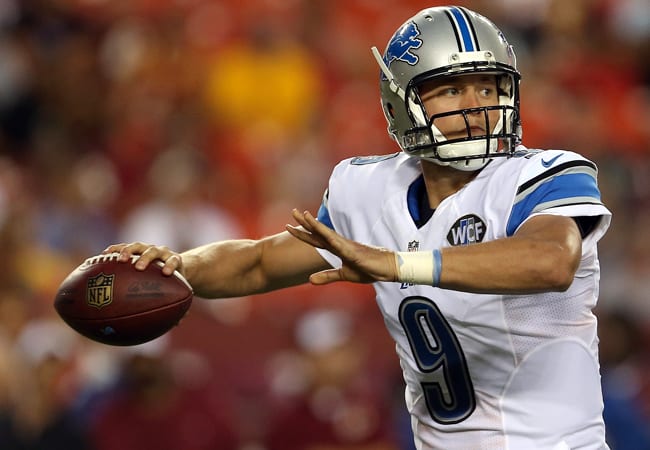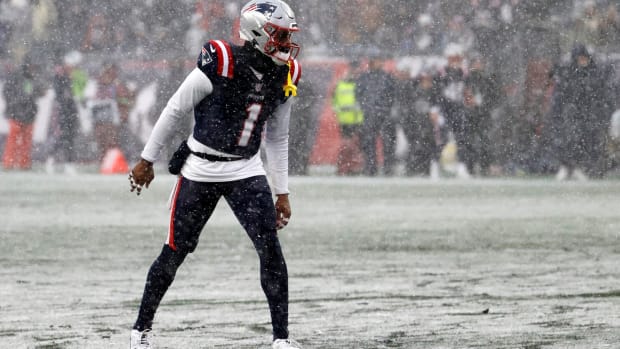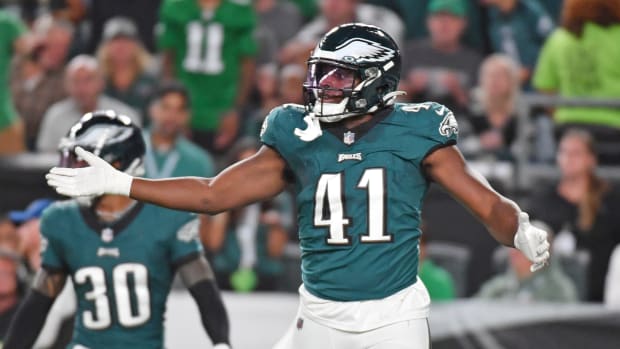Lions and Life After Suh
Every year brings a handful of teams that surprise us, in ways both good and bad. Predicting who it will be in any given season is a fool’s errand; that’s never stopped anyone before. And it won’t here.
Sorry Michiganders, you’re not going to like the way this prediction goes.
The Lions are coming off an 11-5 season that saw them reach the playoffs for only the second time in 15 years. Four of their 11 victories came in games decided by four points or fewer—each of those wins featuring a Matthew Stafford-led late-fourth quarter go-ahead drive. The Lions were on the wrong end of just two close games: Week 5 against the Bills and the Wild-Card loss at Dallas.
In the NFL, a close, hard-fought victory can be every bit as commendable as a rock-solid one. But watching the Lions on film week to week, this looked like a club that was, in some ways, eking by and searching for an identity. The only sure thing about them was that they could stop the run. They ranked first league-wide in rushing yards allowed, both per game and carry. This despite being a defense that, prior to the snap, often aligned both safeties deep.
Strong safety James Ihedigbo is one of the league’s best at filling down into the box after the snap, but he wasn’t the driving force behind the run D’s stinginess. Inside linebacker DeAndre Levy was as good as anyone at his position, showing fluidity, quickness and an understanding of angles week in and week out. But he wasn’t the driving force either. You can probably guess who was. (You probably knew already.) And so you also know he now plays in Miami.
Ndamukong Suh, with suddenness off the snap and man-child power, could command double-teams and still collapse blocking structures. He’s not the only interior difference-maker up front who left in free agency. Nick Fairley, who played with tremendous strength and leverage, is now in St. Louis. And sturdy backup C.J. Mosley is also in Miami.
Besides a formidable run wall, Suh and Fairley gave the Lions a dimensional four-man pass rush through stunts and twists, often creating one-on-one scenarios for rising star end Ziggy Ansah and the pliable Jason Jones. To fill the defensive tackle void, the Lions traded for Haloti Ngata. At 31, the longtime Raven can still dominate, but stylistically, he’s really more of a replacement for Fairley, not Suh. The problem is, Ngata is the only replacement Detroit brought in. Suh’s vacancy will be filled by a rotation featuring the likes of ex-Saints fringe man Tyrunn Walker, fourth-round rookie Gabe Wright, last year’s fifth-rounder Caraun Reid and journeyman Jermelle Cudjo. (General rule of thumb: the more guys in contention for playing time at a single position, the worse shape that position is in.)
Second-year defensive coordinator Teryl Austin, formerly the Ravens’ secondary coach, will have to approach the game differently this season. Last year, Austin did a great job with coverage changeups, infusing new life into a defense that had been schematically vanilla for the previous five years under Jim Schwartz. But Austin’s changes were mostly coverage-based; the Lions cycled from zones to man to hybrid matchup zones. This variety, employed behind an often-dominant front four, obfuscated the fact that the Lions weren’t really all that good at cornerback.
History says their luck here will run out in 2015. In the NFL, all weaknesses get exposed eventually. Darius Slay, a second-round pick in 2013, found his NFL footing, putting together a very solid year in perimeter isolation coverage, but he wasn’t impermeable and isn’t necessarily feared. Across from him is where the Lions scratched a winning lottery ticket; Rashean Mathis, now 35, had previously spent his entire career in zone-based schemes. Mathis held up surprisingly well in man-to-man, but by starting him again the Lions are essentially buying more lottery tickets with last year’s small winnings. The one positive in the secondary is that GM Martin Mayhew did find a potential replacement for Cassius Vaughn, a slot defender upon whom opposing quarterbacks feasted. The leading contender for this spot is Josh Wilson, though there’s also 2014 fourth-rounder Nevin Lawson. In case Lawson, working his way back from a foot injury, isn’t ready Mayhew signed veteran Chris Owens and spent a third-round pick on Alex Carter (perhaps long-term security).
At least solidity at safety can help stabilize the cornerback situation. Mayhew’s underappreciated free-agent signing from two years ago, Glover Quin, continues to pay dividends, spurring much of the versatility that Austin has constructed his scheme around.
Overall, though, it’s a pretty average defensive backfield. And Austin’s coverage changeups, which could compel quarterbacks to hold the ball a beat longer, won’t have the same effect without an interior pass rush pushing the pocket. Austin will have to do more of what he’s done selectively but effectively: bring pressure. This will demand more diversity with his fronts and an increased willingness to take chances. Expect Ansah to move around even more as a joker, and expect plenty of blitzes from Levy, who is great in this capacity. An excellent illustration of this blueprint—and the unfortunate dichotomy that came from it—was the Wild-Card game at Dallas. In the first half, the Lions brought the heat and ate Tony Romo alive. But then Mathis got hurt, the secondary thinned and Austin got cautious and kept more bodies in coverage. That’s when the Cowboys got hot.
Hindsight is 20/20, of course. Austin might have continued to bring pressure only to watch Dez Bryant torch No. 4 cornerback Mohammed Seisay (now a Seahawk). We’d be wondering why Austin didn’t amend his scheme to hide his diminished personnel. The point: holes in any part of a lineup force a coach to make tough decisions. With more holes in the lineup this year, Austin’s job is more difficult.
And this is just the pass defense. It’s even harder to hide leaks in your run defense, especially when the leaks are right up the middle. Levy, a sensational reader-and-reactor, will have less space and more bodies around him in 2015. At Mike ’backer, don’t be surprised if Austin goes with the less dynamic Stephen Tulloch (coming off a torn ACL) instead of up-and-comer Tahir Whitehead. This would indicate conservativeness on the defensive coordinator’s part. Tulloch, a 10th-year veteran, knows where to go; Whitehead doesn’t always, but he gets there more explosively.
If the Lions are to survive their defensive downgrades, they’ll have to take more schematic chances in 2015. In the past, they compensated for their defense with a higher-powered offense. It made them fun to watch, but also fun to play against. They registered just 21 victories from 2011-13. It seem they’ll be pushed into a similar approach in 2015.

Matthew Stafford played generally mistake-free football last year. But with a likely need for more points, will the old gunslinger re-appear? (Matt Hazlett/Getty Images)
Lions Nickel Package
1. Head coach Jim Caldwell is an offensive guy, but Detroit’s system has much of second-year coordinator Joe Lombardi’s stamp on it. Lombardi installed some of the concepts he learned as quarterbacks coach under Sean Payton in New Orleans. These show up mostly in Detroit’s running game, screen game and more conservative pass protection principles. Matthew Stafford’s numbers declined in his first year in this system, but he finally played with near-regular discipline. The $64,000 question: With Stafford presumably more comfortable in the voluminous scheme, will he maintain that discipline or renew his cavalier ways?
2. Perhaps one reason Stafford was more disciplined in 2014 was that Calvin Johnson’s injuries robbed the QB of his wide-casting safety net. Stafford, who can throw with velocity from multiple platforms and arm angles, couldn’t always just sling the ball to his superstar. This is just a hypothesis, though. Stafford’s numbers in the six games where Johnson was either out or noticeably hampered were basically identical to his numbers in games during which Johnson was healthy. But the games without Johnson also came earlier in the season, when Stafford was less comfortable in the system.
3. If the Lions don’t get more out of tight end Eric Ebron, they’ll have no chance at the postseason. Johnson and Golden Tate are a well-fit tandem; Johnson stretches the field vertically while Tate, with his shiftiness and stop/start control, stretches it horizontally. But such contrasting styles also makes a straightforward coverage gameplan more possible. We saw this last season, when opposing defenses regularly put their biggest corner on Johnson (often with safety help) and their quickest (which usually also means smallest) corner on Tate. There has to be a pass-catching weapon who forces defensive coordinators to make difficult decisions about who to put on the field and in what coverages. That’s what the freakishly athletic Ebron was drafted 10th overall in 2014 to be. But as a rookie, Ebron was rough around the edges in just about all facets.
4. Second-round rookie running back Ameer Abdullah has intriguing raw physical traits. The man he’ll eventually replace, Joique Bell, does not. Bell is 5-11, 230 but runs with the measured control (a more callous term: sluggishness) of a 245-pounder. He does, however, have lighter feet than you’d expect, making him surprisingly viable on screens and with the occasional cutback. But obviously, if the Lions thought these traits could shine all the time they wouldn’t have drafted Abdullah. Especially considering that the depth at running back was already set, with Theo Riddick providing quickness and burst as a receiver out of the backfield.
5. Left tackle Riley Reiff must get a little sounder. He was beat in a few critical scenarios last season, including some instances in which he had a tight end helping him. That should never happen. Reiff is the most talented player along what, in terms of athleticism, is a very average front five.
• Questions or comments? Email us at talkback@themmqb.com





































